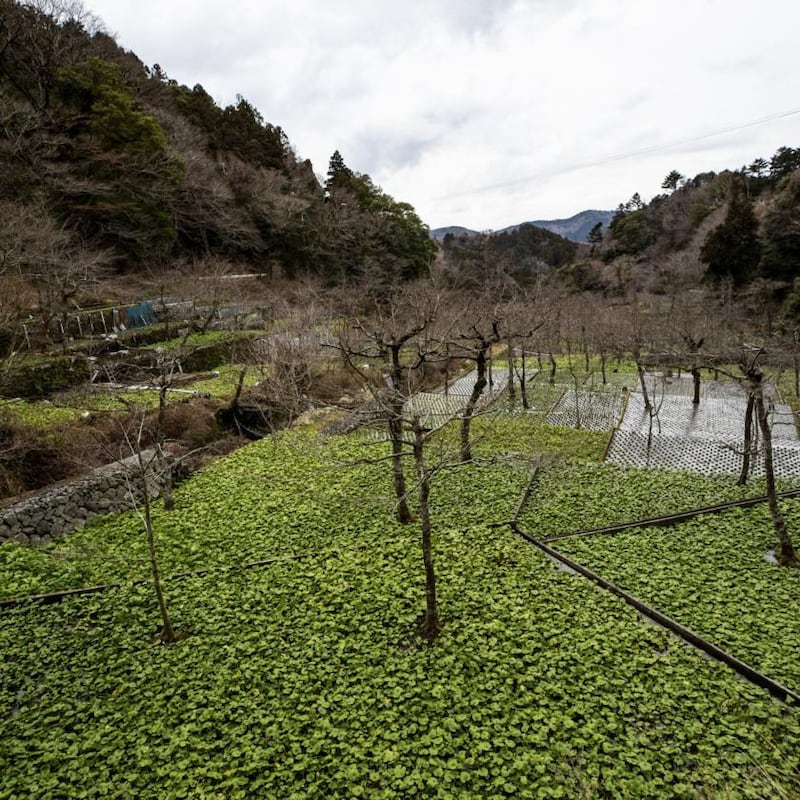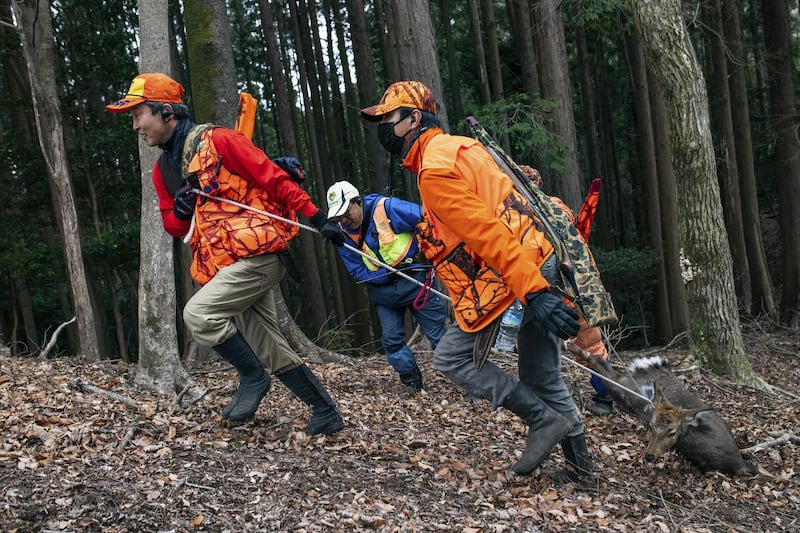For three decades, Mitsuyasu Asada has proudly tended the same lush mountainside terraces where his father and grandfather grew wasabi, the horseradishlike plant with a fluorescent-green hue and head-clearing pungency that unmistakably connotes Japanese cuisine.
Yet at the age of just 56, Asada is already thinking about retiring, worn down by the many threats facing this indispensable condiment that graces plates of sushi and bowls of soba.
Rising temperatures have rendered his crops more susceptible to mould and rot. He worries about unpredictable rainfall, deluging floods and more intense typhoons. The thick cedar forest that blankets the mountain overlooking his paddies – a result of postwar timber policy – has degraded the quality of the spring water that the wasabi needs to grow. Wild boar and deer increasingly attack his fields, driven down the mountains for lack of nutrition at higher altitudes.
And his two adult daughters have married and shown no interest in succeeding him on his one and a half acres in Izu, a city in Shizuoka prefecture, about 90 miles southwest of Tokyo, Japan.
“If no one will take it over,” Asada said, “it will end.”

Asada is just one of many growers in Shizuoka, one of Japan’s largest wasabi-growing regions, who must confront rising challenges from global warming, the legacy of untended forests and demographic decline.
Already, these hazards have chipped away at the centuries-old culture of wasabi in the area and imperilled the future of one of the prefecture’s most important agricultural products and a pillar of its tourism business.
Over the past decade, the volume of wasabi produced in Shizuoka has declined by close to 55 per cent, according to the Ministry of Agriculture, Forestry and Fisheries.
"I have a sense of crisis," said Hiroyuki Mochizuki, president of Tamaruya, a 147-year-old company in Shizuoka that processes wasabi to sell in tubes, as well as in salad dressings, flavoured salts, pickles and even nostril-tickling chocolate.
“In order to protect Japanese food culture,” he added, “it is important to protect wasabi.”
The wasabi that comes in tubes and packets and is familiar to many diners is actually a blend of wasabi and horseradish dyed green – or contains no wasabi at all. In Japan, chefs at higher-end sushi, soba or grilled beef restaurants grate fresh wasabi at the counter, so customers can experience the acute assault on their nostrils and the unique flavour that lingers for just a moment on the tongue.
'In a way, it is a closed society, made up of people who have grown wasabi for generations'
For hundreds of years, wasabi grew wild in mountains across Japan, blooming near forests and huddling alongside streams. About four centuries ago, growers in Shizuoka started to cultivate wasabi as a crop.
Wasabi plants sprout in spring water that flows down from the mountains, helping to foster gradations of pungency and hints of sweetness. The most well-known Shizuoka variety, called mazuma, tends to sell for 50 per cent more than wasabi from other parts of Japan.
Over time, local growers say, the spring water has deteriorated in quality, compromised by an abundance of cedar and cypress trees.
In an effort to supply Japan with a fast-growing source of lumber to rebuild after the second World War, government planners seeded mountain tracts exclusively with Japanese cedar or cypress.
But as cheap wood imports supplanted Japan’s lumber in the 1960s, the cedar and cypress were left to grow, crowding out other kinds of plants that would better contain and nourish the mountain springs that wasabi needs to thrive.
"People talk about climate change and how there is less water," said David Hulme, a retired Australian journalist who now grows wasabi in Okutama, about 50 miles from central Tokyo. "But the real problem is that the hills are not holding the water long enough."
Global warming has upset the balance even further. The delicate wasabi plants, which take more than a year to mature, do best in conditions no higher than about 20 degrees. In recent years, heat waves in Japan have regularly pushed temperatures into the 30s , causing more stalks to rot.

On a recent afternoon, Masahide Watanabe (66), a fourth-generation grower, stepped into one of his paddies in blue waders. With a small hoe, he dug a wasabi plant from the mud, unearthing a pockmarked green rhizome sprouting leaves shaped like water lilies.
He rinsed the plant in flowing spring water and chopped off the leaves and a tangle of roots, inspecting the remaining body for blemishes.
“Sometimes the plant will be missing the stems that grow out of the top,” he said. “We call it ‘headless syndrome.’” Other times, he said, he discovers what look like tumours on the roots. Such diseases, he said, have grown more frequent as temperatures have warmed.
Government researchers and local growers have started to experiment with crossbreeding in an effort to develop hearty wasabi varieties that will thrive even in the rising heat.
The challenge is that, unlike with other crops such as cucumbers or tomatoes, extracting seeds and growing seedlings from wasabi require sophisticated technology. Most growers rely on specialised companies to clone seedlings in labs and greenhouses. Crossbreeding new varieties entails complicated pollination efforts and, most of all, time.
"It can take five or six or up to 10 years for the whole process and to figure out which is the best or strongest," said Susumu Hisamatsu, director of the wasabi production technology division in the Shizuoka Research Institute of Agriculture and Forestry.
As farmers approach retirement age, some are left without successors to continue the wasabi-growing tradition
Even if the hundreds of experiments conducted by government researchers do yield a variety that can better withstand the heat, there is no guarantee that it will taste good or sell well.
Kichie Shioya (65), whose family farm stretches back to the 19th century and who heads the Federation of Wasabi Cooperatives in Shizuoka prefecture, said that when he tried one of the new crossbreeds developed by the prefectural research centre, the plants “didn’t grow well, or caught diseases.”
Some experts who study wasabi say modern growers may have already diminished the possibility of developing environmentally resilient plants because they have focused for so long on a tiny cluster of breeds.
"Now one kind of wasabi dominates the market," said Kyoko Yamane, an expert in wasabi cultivation at Gifu University. That makes it difficult to produce healthy hybrids.
Growers may not stay in the business long enough to try the new crossbreeds. As farmers approach retirement age, some are left without successors to continue the wasabi-growing tradition.
Watanabe, the fourth-generation grower, reluctantly returned to Izu from Tokyo 40 years ago after graduating with a degree in chemistry. He said his son, enrolled at a university in Tokyo, was likely to hunt for a job in the city.

“There is a risk that wasabi could disappear,” Watanabe said.
Hope may yet come from people such as Haruhiko Sugiyama, 44, who recently started his own wasabi-growing operation in Izu. He leases a half-acre of paddies from a retired grower whose own son does not want to enter the family business.
A dozen years ago, Sugiyama, the son of grocery store owners, decided he wanted to work outside. A middle school friend who descended from a long line of wasabi growers connected him to another farmer who needed help.
Yet to reach the point where he could start his own operation, Sugiyama had to prove his worth to the local growers association, which controls access to wasabi fields. In 12 years working for another grower, Sugiyama said, he never took a day off while learning every step of local wasabi-growing techniques.
“In a way, it is a closed society, made up of people who have grown wasabi for generations,” said Sugiyama, who was ultimately granted approval to take over abandoned paddies. “If I were not recognised by the association, they would not help me or allow me to grow on favourable land.”
In a sign of the bond he has built with fellow growers, on a recent morning, his middle school friend and another farmer helped cut down a 30-foot cypress tree that had blocked sunlight from getting to some of Sugiyama’s paddies.
As the growers winched the downed tree onto the bank of a stream that fed into Sugiyama's paddies, he gazed down at two empty terraces, the clear water now reflecting the blue sky above. "Next month," he said, "I will plant them." – This article originally appeared in The New York Times


















